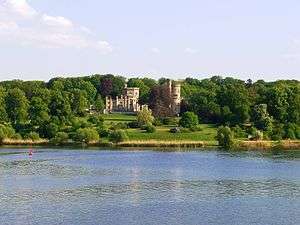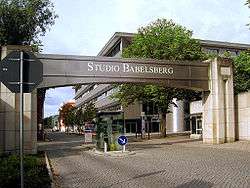Babelsberg

Babelsberg is the largest district of the Brandenburg capital Potsdam in Germany. The affluent neighbourhood named after a small hill on the Havel river is famous for Babelsberg Palace and Park, part of the Palaces and Parks of Potsdam and Berlin UNESCO World Heritage Site, as well as for Babelsberg Studio, a historical centre of the German film industry and the first large-scale movie studio of the world.
History

A settlement on the small Nuthe creek was first mentioned in the 1375 Landbuch (domesday book) by Emperor Charles IV of Luxembourg, who also ruled as Margrave of Brandenburg since 1373. Then called Neuendorf (New Village) after its former West Slavic name Nova Ves, it was shelled several times and was severely damaged during the Thirty Years' War.
In the mid 18th century a new village was founded by King Frederick II of Prussia and settled with Protestant Bohemian expellees, predominantly weavers who as descendants of the Unity of the Brethren had fled from the suppression in the lands of the Habsburg Monarchy under Empress Maria Theresa of Austria. During the Industrial Revolution it developed into a centre of textile manufacturing and, at the premises of Orenstein & Koppel, from 1899 on also of the railway production. For decades German Neuendorf and Bohemian Nowawes (Czech: Nová Ves) bordered on each other but remained separate municipalities until their official unification in 1907. Nowawes received town privileges in 1924.

From about 1900 the mansion colony of Neubabelsberg arose east of Babelsberg Park on the southern shore of the Griebnitzsee lake. After the Universum Film AG (UFA) in 1922 had acquired a large backlot nearby, these villas built by famous architects like Hermann Muthesius and Ludwig Mies van der Rohe became popular residences of numerous film stars. Marika Rökk, Sybille Schmitz, Lilian Harvey, Willy Fritsch and Brigitte Horney lived and worked here when film production by the UFA continued without a break in the Nazi period, while many Jewish actors and directors were dispossessed and had to flee from Germany. In 1938 Nowawes and Neubabelsberg merged and were incorporated into Potsdam one year later, becoming the district of Potsdam-Babelsberg.
During the 1945 Potsdam Conference the representatives of the victorious Allies Joseph Stalin, President Harry S. Truman and Prime Minister Winston Churchill (succeeded by Clement Attlee) resided in mansions of Neubabelsberg. At the "Truman-Villa" the President issued the Potsdam Declaration and gave orders for the atomic bombings of Hiroshima and Nagasaki. Today the building serves as the seat of the liberal Friedrich Naumann Foundation.

Babelsberg Palace
In 1833 Prince Wilhelm of Hohenzollern had reached the consent by his father King Frederick William III of Prussia to build a summer residence for him and his spouse Augusta of Saxe-Weimar-Eisenach on the slope of the Babelsberg hill, overlooking the Havel river. The first plans were designed in a Neo-Gothic style by Karl Friedrich Schinkel, but soon did not satisfy the growing demands of Wilhelm, who - as the marriage of his elder brother King Frederick William IV produced no children - meanwhile had achieved the status of a Prussian crown prince. The palace was largely extended according to plans by Friedrich Ludwig Persius and finished in 1849.
Babelsberg remained a residence of Wilhelm after his accession to the Prussian and German throne. It was here, where after a private conversation on 23 September 1862 he appointed Otto von Bismarck Minister President of Prussia and refrained from abdicating.
Babelsberg today
Because of the closeness to Berlin and Potsdam, Babelsberg's history has much in common with its neighbours, notably the common history of Prussia, the Partition of Germany during the Cold War and German reunification. The neighbourhood shares a direct border with the Wannsee district of Berlin, there are some remains of the Berlin Wall left.

Studio Babelsberg is widely known as a European media centre and the oldest large-scale film studio in the world. It is also one of the two seats of the public Rundfunk Berlin-Brandenburg (rbb) broadcaster and home of the German Broadcasting Archive.
Since 1990 Babelsberg Palace with the surrounding park laid out by Peter Joseph Lenné and Hermann von Pückler-Muskau is part of the UNESCO Palaces and Parks of Potsdam and Berlin World Heritage Site. One campus of the University of Potsdam as well as the Leibniz Institute for Astrophysics Potsdam (AIP) are situated within the park. Adjacent Neubabelsberg is the home of the Hasso Plattner Institute for software systems engineering.
The local SV Babelsberg 03 football club is based at the Karl-Liebknecht-Stadion, which is also the home ground of the 1. FFC Turbine Potsdam women's football team.
The German Industrial-Metal band Rammstein used Babelsberg castle to film their music video "Du Riechst So Gut 98".
See also
Sources
- Paul Sigel, Silke Dähmlow, Frank Seehausen and Lucas Elmenhorst, Architekturführer Potsdam - Architectural Guide, Dietrich Reimer Verlag, Berlin 2006, ISBN 3-496-01325-7.
- Jung, Karin Carmen: Die Böhmische Weberkolonie Nowawes 1751–1767 in Potsdam-Babelsberg. Bauliche und städtebauliche Entwicklung. Haude und Spener, ISBN 3-7759-0407-7.
- Grampp, Hermann: Filmstadt Babelsberg. In: Die Mark Brandenburg, Heft 74, Marika Großer Verlag, Berlin 2009 ISBN 978-3-910134-12-6.
- Babelsberg. Einst und Jetzt. Culturcon / Märkische Oderzeitung, 2011, ISBN 978-3-941092-77-8.
External links
| Wikimedia Commons has media related to Babelsberg. |
- Babelsberg Palace - official site
- Babelsberg on www.potsdam.de
- Babelsberg Palace
- Local tradesmen website (German)
Coordinates: 52°24′N 13°06′E / 52.400°N 13.100°E